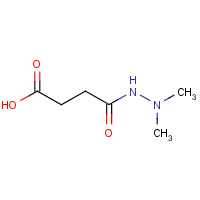Daminozide
Agent Name
Daminozide
CAS Number
1596-84-5
Formula
C6-H12-N2-O3
Major Category
Pesticides

Synonyms
2,2-Dimethylhydrazid kyseliny jantarove [Czech]; ALAR; Alar 85; Aminozide; B 995; B-Nine; Bernsteinsaeure-2,2-dimethylhydrazid [German]; Butanedioic acid mono(2,2-dimethylhydrazide); DMASA; DYaK; Dimas; Dimethylaminosuccinamic acid; Kylar; N-(Dimethylamino)succinamic acid; N-Dimethylamino-succinamidsaeure [German]; SADH; Succinic 1,1-dimethyl hydrazide; Succinic N',N'-dimethylhydrazide; Succinic acid 2,2-dimethylhydrazide; Succinic acid N,N-dimethylhydrazide; [ChemIDplus]
Category
Plant Growth Regulators
Description
White solid; [HSDB] White crystals; [MSDSonline]
Sources/Uses
Used as a systemic plant growth regulator on ornamentals and bedding plants in enclosed structures such as greenhouses, shadehouses, and interiorscapes; [HSDB] Registered for use on ornamentals in greenhouses; [Reference #1]
Comments
"Symptoms of exposure to this compound may include convulsions, coma, liver and kidney damage and irritation to the gastrointestinal tract and respiratory tract." [CAMEO] May cause irritation; [MSDSonline] Unsymmetrical dimethylhydrazine is a metabolite in the body; [Reference #1] See "1,1-Dimethylhydrazine."
Restricted
All food uses voluntarily cancelled in 1989; [Reference #1]
Reference Link #1
Biomedical References
Exposure Assessment
Vapor Pressure
0.0002 mm Hg
Lethal Concentration
LC50 (rat) > 147,000 mg/m3/1h
Adverse Effects
Neurotoxin
Other CNS neurotoxin
Hepatotoxin
Hepatoxic (a) from occupational exposure (secondary effect) or (b) in animal studies or in humans after ingestion
Diseases, Processes, and Activities Linked to This Agent
Processes
Industrial Processes with risk of exposure: